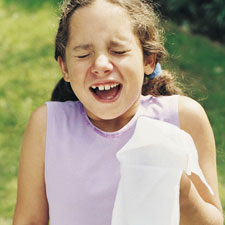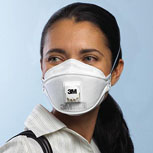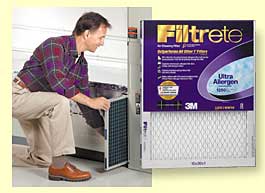How To Survive Pollen Season - March 2013
Hello, Subscriber, Spring is on the way, and in many parts of the country, warmer weather will be welcome this year. Unfortunately, spring brings a problem for millions of Americans — pollen. To help survive pollen season and escape the symptoms of sneezing, sniffling, runny nose, and watery eyes, read the tips below on how to Avoid Pollen Outdoors, Minimize Pollen Indoors, and Reduce Your Personal Pollen Count.
Spring is on the way, and in many parts of the country, warmer weather will be welcome this year. Unfortunately, spring brings a problem for millions of Americans — pollen. To help survive pollen season and escape the symptoms of sneezing, sniffling, runny nose, and watery eyes, read the tips below on how to Avoid Pollen Outdoors, Minimize Pollen Indoors, and Reduce Your Personal Pollen Count.
 This method also rinses the nasal and sinus passages, but you have more control over the flow with positive pressure irrigation.
Another type of positive pressure irrigation is a mechanized device that gently sends pulsing streams of water into your nose and sinuses in a motion that mimics the natural motion of the cilia (tiny hairs in the nose that control the movement of mucus). Which nasal/sinus irrigation method you choose is a matter of personal preference; all are effective at rinsing away pollen.
This method also rinses the nasal and sinus passages, but you have more control over the flow with positive pressure irrigation.
Another type of positive pressure irrigation is a mechanized device that gently sends pulsing streams of water into your nose and sinuses in a motion that mimics the natural motion of the cilia (tiny hairs in the nose that control the movement of mucus). Which nasal/sinus irrigation method you choose is a matter of personal preference; all are effective at rinsing away pollen.

 Spring is on the way, and in many parts of the country, warmer weather will be welcome this year. Unfortunately, spring brings a problem for millions of Americans — pollen. To help survive pollen season and escape the symptoms of sneezing, sniffling, runny nose, and watery eyes, read the tips below on how to Avoid Pollen Outdoors, Minimize Pollen Indoors, and Reduce Your Personal Pollen Count.
Spring is on the way, and in many parts of the country, warmer weather will be welcome this year. Unfortunately, spring brings a problem for millions of Americans — pollen. To help survive pollen season and escape the symptoms of sneezing, sniffling, runny nose, and watery eyes, read the tips below on how to Avoid Pollen Outdoors, Minimize Pollen Indoors, and Reduce Your Personal Pollen Count.
Avoid Pollen Outdoors
You may be thinking that avoiding pollen outdoors is easier said than done. And that is true, as we all have to go outdoors, even if only to get from home to the car and then from the car to the office or store. But you can be smart about pollen and significantly reduce your exposure. Here are some tips:- Check the pollen count
 and really try to stay indoors when the count is extremely high.
and really try to stay indoors when the count is extremely high. - Get someone else to do yard work, exercise indoors, and leave outside projects until the pollen settles down. When you can't, wear a mask to avoid inhaling pollen.
- Change the cabin air filter in your car once a year or every 12-15 thousand miles. This will help keep the air in your car clean by capturing particles.
- Utilize a portable car air purifier to capture particles and odors.
- Be strategic about when you go outdoors. Pollen is less prevalent on rainy, cloudy, or windless days, and the air is most saturated with pollen on days when it is hot, dry, and windy.
- Wipe pets as they come indoors. Pollen sticks to the fur of your dog or cat and transfers to your carpet, upholstery, and you.
- Resist the temptation to dry clothes outdoors when the pollen count is high on fine spring days.
Minimize Pollen Indoors
Pollen will sneak into your home this spring. It's a fact of life. Some will waft in on the air, and some will hitchhike on clothing and pets. Even if you keep windows closed and slip in and out the door really fast, pollen will find its way indoors. Here are some tips to keep pollen at a minimum in your indoor air:- Keep doors and windows closed as much as possible at home and in the car. If you have to have a breath of fresh, spring air, try a window screen filter.
- An air purifier can help reduce your indoor pollen count. A HEPA air purifier uses a fan to circulate air and pull the pollen-laden air through the filters where it is trapped.
- Other means of filtration that can help are furnace filters
 that utilize your HVAC system to pull air through filter material to capture particles.
that utilize your HVAC system to pull air through filter material to capture particles.
They only work when the fan on your system is on, but you can set your system to run the fan continuously, which can be especially helpful during the pollen system. For any particles that slip through or around the furnace filter, you can economically attach filter material to your vent covers. It is recommended to only cover the vents in 2 or 3 rooms so that there is no strain on your system. The bedrooms are the best place to start since you spend more time in the bedroom than in other rooms. - On days with particularly high pollen counts, it can help to remove clothes and hop in the shower after being outside because pollen is sticky, and what is on you will transfer to your home for you to inhale later. Wash those clothes in an allergen-reduction laundry detergent.
- Pollen is a component of dust, so frequent dusting and vacuuming during pollen season can help reduce the pollen count inside your home.
Reduce Your Personal Pollen Count
No matter how hard you try not to, you will inhale pollen. If you are allergic to pollen, your body will fight back against this perceived danger, and you will start sneezing, sniffling, and more. But you can reduce the pollen that is adhering to your nasal and sinus passages with nasal/sinus irrigation. There are two main methods of irrigation: gravity-based and positive pressure. In both, a water and salt solution rinses the nasal and sinus passages. You can either purchase pre-mixed solution or packets of a saline powder to be mixed with water or you can make your own solution. The American Academy of Allergy, Asthma, and Immunology (AAAAI) gives this recipe for saline solution:Ingredients:Directions:
- Salt-containing no iodide, anti-caking agents or preservatives, as these can be irritating to the nasal lining (Kosher, pickling, or canning salts are usually good choices)
- Baking soda
- 8 ounces (1 cup) of lukewarm distilled or boiled water
- In a clean container, mix 3 heaping teaspoons of iodide-free salt with 1 rounded teaspoon of baking soda and store in a small airtight container.
- Add 1 teaspoon of the mixture to 8 ounces (1 cup) of lukewarm sterile, distilled, or boiled water.
Gravity-based irrigation is just what it sounds like. The water flows through nasal and sinus passages simply by flowing downhill due to gravity. You hold your head sideways and pour water in one nostril, and it flows naturally through the nose and sinuses, rinsing out pollen and other debris. The neti pot is an example of this method.
Positive pressure irrigation uses the force of a squeeze bottle or syringe-type irrigator to push water through the nasal and sinus cavities.Summary
Spring can be a nightmare for allergy sufferers, but now you know there are steps to take to avoid pollen and ease the discomfort. Taking a few precautions and implementing a few simple measures can make a big difference in surviving pollen season and feeling better this spring.
